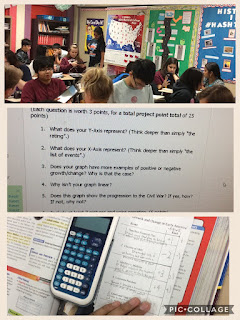Math in History Education
Students have been using math in History this week and I'm eager to hear their reflections today. We have been studying the early years of the American Republic and I created an overarching unit to tie these events together.
Using the theme of growth and change, each student began by reviewing 9 events/ideas and individually ranked them on a scale of +5 (positive change/growth) to -5 (negative change/growth). In group meetings, these historians were asked to average their findings and develop 2 justifications for their averages.
The next step was to graph their findings. I gave them graph paper (the x-axis labeled "events 1-9", the y-axis labeled "rating") and the groups created their graphs.
The final step was to create a Spark Video analyzing their data. They needed to more thoroughly explain the x-axis and y-axis (possible answers: the events show the growth and change of the country over time from Washington's Administration to the Missouri Compromise). I asked an 8th Grade Math teacher for ways to make this analysis more "mathy" and use skills that all middle school math students would know and be able to do--she asked me if the graph would be linear. (Once she re-explained what linear meant I knew it wasn't!) :) The final question was history-related: does this graph show the inevitable progression to the Civil War (many of the students' graphs had a precipitous drop at the Missouri Compromise).
Students will present their graphs to other groups today and there are going to be differences between the graphs--each group will defend and support their decisions and justify their rankings to their peers. It's another example of how history is open to interpretation as long as it's based on facts.
Students will present their graphs to other groups today and there are going to be differences between the graphs--each group will defend and support their decisions and justify their rankings to their peers. It's another example of how history is open to interpretation as long as it's based on facts.
I am very pleased with this assessment. I'm moving into cross-curricular areas I'm not as comfortable with. I am showing my students that it's important to take risks and be vulnerable as a learner. My students that enjoy math had fun with this assessment (one said graphing is his favorite math activity!) and all students have seen how they can challenge themselves to think in new ways.



Comments
Post a Comment